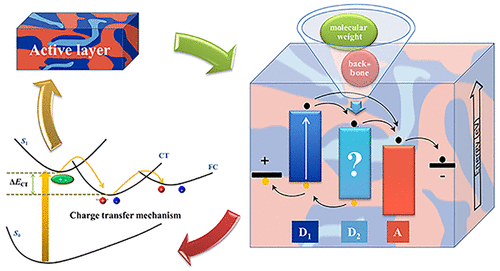当前位置:
X-MOL 学术
›
J. Phys. Chem. Lett.
›
论文详情
Our official English website, www.x-mol.net, welcomes your
feedback! (Note: you will need to create a separate account there.)
Charge Transfer Mechanisms Regulated by the Third Component in Ternary Organic Solar Cells
The Journal of Physical Chemistry Letters ( IF 4.8 ) Pub Date : 2021-09-10 , DOI: 10.1021/acs.jpclett.1c02413 Ming-Yang Li 1 , Yi-Qi Pan 1 , Guang-Yan Sun 1, 2 , Yun Geng 3
The Journal of Physical Chemistry Letters ( IF 4.8 ) Pub Date : 2021-09-10 , DOI: 10.1021/acs.jpclett.1c02413 Ming-Yang Li 1 , Yi-Qi Pan 1 , Guang-Yan Sun 1, 2 , Yun Geng 3
Affiliation

|
For ternary organic solar cells (T-OSCs), introducing the third component (D2) can significantly enhance the efficiency of cell while still maintaining easy fabrication. However, it brings difficulty in physical understanding of the fundamental mechanism because of the more complicated photophysical processes in T-OSCs. Accordingly, how the guest donor D2 regulates the charge transfer mechanism was explored in theory using three T-OSCs containing two donors and an acceptor. The results point out that larger differences in molecular weight and/or backbone between D2 and the host donor D1 cause different charge transfer mechanisms, which hardly provide a coexisting charge transfer path. Besides, strong absorption capacity of D2 with a high oscillator strength would produce favorable regulation of the charge transfer mechanism. Therefore, this work clarifies the influence of D2 on the charge transfer mechanism in T-OSCs, which suggests that the method of improving the power conversion efficiency cannot be generalized but rather must be tailored to specific conditions.
中文翻译:

三元有机太阳能电池中第三组分调控的电荷转移机制
对于三元有机太阳能电池 (T-OSC),引入第三种组分 (D 2 ) 可以显着提高电池效率,同时仍保持易于制造。然而,由于 T-OSCs 中更复杂的光物理过程,它给物理理解基本机制带来了困难。因此,使用包含两个供体和受体的三个 T-OSC 在理论上探索了客体供体 D 2如何调节电荷转移机制。结果指出,D 2和主体供体D 1之间分子量和/或主链的较大差异导致不同的电荷转移机制,这很难提供共存的电荷转移路径。此外,D的吸收能力强2具有高振荡器强度将对电荷转移机制产生有利的调节。因此,这项工作阐明了 D 2对 T-OSC 中电荷转移机制的影响,这表明提高功率转换效率的方法不能一概而论,而必须针对特定条件进行调整。
更新日期:2021-09-23
中文翻译:

三元有机太阳能电池中第三组分调控的电荷转移机制
对于三元有机太阳能电池 (T-OSC),引入第三种组分 (D 2 ) 可以显着提高电池效率,同时仍保持易于制造。然而,由于 T-OSCs 中更复杂的光物理过程,它给物理理解基本机制带来了困难。因此,使用包含两个供体和受体的三个 T-OSC 在理论上探索了客体供体 D 2如何调节电荷转移机制。结果指出,D 2和主体供体D 1之间分子量和/或主链的较大差异导致不同的电荷转移机制,这很难提供共存的电荷转移路径。此外,D的吸收能力强2具有高振荡器强度将对电荷转移机制产生有利的调节。因此,这项工作阐明了 D 2对 T-OSC 中电荷转移机制的影响,这表明提高功率转换效率的方法不能一概而论,而必须针对特定条件进行调整。









































 京公网安备 11010802027423号
京公网安备 11010802027423号